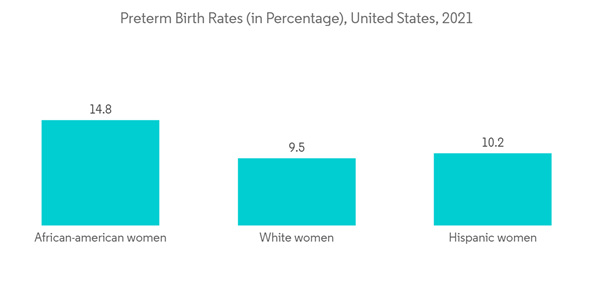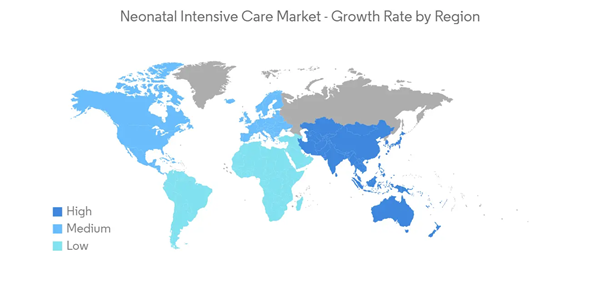The neonatal intensive care market is expected to register a CAGR of 5.5% over the forecast period.
COVID-19 had a significant impact on neonatal intensive care unit services. To stop the spread of COVID-19 many services relating to neonatal care were delayed. Additionally, hospitals were under pressure to treat COVID-19 patients, which was one of the factors preventing hospitals from offering neonatal intensive care services. For instance, as per the report published by Research Square, in February 2022, the average number of home deliveries attended by Skill Birth Attendants (SBA) in 2021 was 15,491. Furthermore, according to a study published by the American Academy of Pediatrics, in November 2021, there is a connection between COVID-19 and multisystem inflammatory syndrome in children (MIS-C). Scientists worldwide, including pediatric specialists, were working together to understand MIS-C and how best to diagnose and treat it. Children who become ill with MIS-C should be treated in the hospital, according to the CDC. Furthermore, according to an article published by Frontiers Media S.A., in February 2021, the mitigation strategies adopted to manage the pandemic upset care delivery for high-risk newborns and their families, and the mental health legacy of the pandemic was endured by both NICU staff and family members long after the acute phase. Even though the market is gradually stabilizing as COVID-19 cases are declining, there is still fear among people regarding infection, which is expected to impact the market's growth.
The rising incidence of preterm births, increasing prevalence of chronic diseases among newborn babies, and technological advancements in neonatal intensive care devices are the factor attributed to the growth of the market over the forecast period. For instance, as per the systemic review published by the International Journal of Contemporary Pediatrics, in September 2021, the world's highest prevalence of low birth weight (LBW) was found in South Asia. More than half of LBW babies worldwide, 15% of all births come from Asia. Additionally, as per the WHO, in November 2022, an estimated 15 million babies globally are born prematurely every year which accounts for more than 1 in 10 babies. These factors have increased the market demand for neonatal intensive care.
Furthermore, hospitals and neonatal care units are focused on improving neonatal care with more sophisticated systems, and adopting these technological procedures boosts market growth. For instance, in March 2021, Florida Perinatal Quality Collaborative launched an infant health quality improvement initiative PAIRED focusing on improving family-centered care in participating Florida NICUs. Hence this kind of technological advancement boosts market growth.
The factors such as the rising incidence of preterm births, increasing prevalence of chronic diseases among newborn babies, and technological advancements in neonatal intensive care devices, the neonatal intensive care market is likely to grow over the forecast period. However, lack of awareness and economic constraints in developing countries and decreasing birth rates in developed countries restrain the market’s growth.
Technological advancements in the development of low-cost incubators, which is also contributing to market growth. For instance, in February 2021, a low-cost incubator was developed by scientists from the University of Maryland and conducted a successful clinical trial in India. A standard incubator found in a newborn intensive care unit costs between USD 1,500 and USD 35,000 which is beyond the means of many hospitals in low- and middle-income countries. Public impact research initiated by the students of the University of Maryland has culminated in the successful clinical trial of an incubator that costs only USD 200.
As per the factors such as increased birth rates, research, and development in the field of neonatal care, and product launches, the incubator segment is expected to grow over the forecast period.
Furthermore, according to an article published by the Journal of Pediatrics & Neonatal Care, in November 2022, the prevalence of culture-confirmed neonatal sepsis was 4.3% among newborns in Southern-Eastern Mexico.
Companies are actively involved in product innovations and technological advancements to ensure better recognition, push product sales, and meet the increasing demand. For instance, in October 2021, Movair launched Luisa, a portable and life-supporting ventilator with high-flow oxygen therapy in the United States. The device can be used in homes, hospitals, or institutions. Such development is expected to drive the growth of the market over the forecast period.
Thus, factors such as the presence of well-established healthcare facilities and the surge in the number of neonatal fetal deaths, the market is expected to witness significant regional growth over the forecast period.
This product will be delivered within 2 business days.
COVID-19 had a significant impact on neonatal intensive care unit services. To stop the spread of COVID-19 many services relating to neonatal care were delayed. Additionally, hospitals were under pressure to treat COVID-19 patients, which was one of the factors preventing hospitals from offering neonatal intensive care services. For instance, as per the report published by Research Square, in February 2022, the average number of home deliveries attended by Skill Birth Attendants (SBA) in 2021 was 15,491. Furthermore, according to a study published by the American Academy of Pediatrics, in November 2021, there is a connection between COVID-19 and multisystem inflammatory syndrome in children (MIS-C). Scientists worldwide, including pediatric specialists, were working together to understand MIS-C and how best to diagnose and treat it. Children who become ill with MIS-C should be treated in the hospital, according to the CDC. Furthermore, according to an article published by Frontiers Media S.A., in February 2021, the mitigation strategies adopted to manage the pandemic upset care delivery for high-risk newborns and their families, and the mental health legacy of the pandemic was endured by both NICU staff and family members long after the acute phase. Even though the market is gradually stabilizing as COVID-19 cases are declining, there is still fear among people regarding infection, which is expected to impact the market's growth.
The rising incidence of preterm births, increasing prevalence of chronic diseases among newborn babies, and technological advancements in neonatal intensive care devices are the factor attributed to the growth of the market over the forecast period. For instance, as per the systemic review published by the International Journal of Contemporary Pediatrics, in September 2021, the world's highest prevalence of low birth weight (LBW) was found in South Asia. More than half of LBW babies worldwide, 15% of all births come from Asia. Additionally, as per the WHO, in November 2022, an estimated 15 million babies globally are born prematurely every year which accounts for more than 1 in 10 babies. These factors have increased the market demand for neonatal intensive care.
Furthermore, hospitals and neonatal care units are focused on improving neonatal care with more sophisticated systems, and adopting these technological procedures boosts market growth. For instance, in March 2021, Florida Perinatal Quality Collaborative launched an infant health quality improvement initiative PAIRED focusing on improving family-centered care in participating Florida NICUs. Hence this kind of technological advancement boosts market growth.
The factors such as the rising incidence of preterm births, increasing prevalence of chronic diseases among newborn babies, and technological advancements in neonatal intensive care devices, the neonatal intensive care market is likely to grow over the forecast period. However, lack of awareness and economic constraints in developing countries and decreasing birth rates in developed countries restrain the market’s growth.
Key Market Trends
Incubators Segment is Expected to Cover a Significant Share Over the Forecast Period
A neonatal incubator is an enclosure in which an infant can be kept in a controlled environment for observation and care. The device may also include a heater, a fan, a container for water to add humidity, a control valve through which oxygen may be added, and access ports for nursing care. It is used in preterm births or for some ill full-term babies to observe and treat them in a stabilized environment. It may additionally be used to evaluate and treat sick neonates. Increased birth rates, research, and development in the field of neonatal care, and product launches boost the market growth. For instance, in April 2022, WHO launched a series of documents and updated guidelines to improve the care of newborns. It focuses on the foundation of the essential care of every newborn. Thus, the increase in birth rate along with the increase in the initiative is expected to drive the growth of the segment.Technological advancements in the development of low-cost incubators, which is also contributing to market growth. For instance, in February 2021, a low-cost incubator was developed by scientists from the University of Maryland and conducted a successful clinical trial in India. A standard incubator found in a newborn intensive care unit costs between USD 1,500 and USD 35,000 which is beyond the means of many hospitals in low- and middle-income countries. Public impact research initiated by the students of the University of Maryland has culminated in the successful clinical trial of an incubator that costs only USD 200.
As per the factors such as increased birth rates, research, and development in the field of neonatal care, and product launches, the incubator segment is expected to grow over the forecast period.
North America is Expected to Cover a Significant Share Over the Forecast Period
North America is expected to hold a significant share of the neonatal intensive care market and is likely to continue over the forecast period. This can be attributed to the presence of well-established healthcare facilities and the rise in the demand for advanced healthcare systems. As the number of devices approved by the regulatory authorities has increased, the value-based healthcare model has encouraged the growth of highly specialized NICU centers. The surge in the number of neonatal fetal deaths in the region will likely supplement the market growth over the analysis period. For instance, as per the CDC update in August 2021, in the United States, about 2% to 10% of pregnancies are affected by gestational diabetes. Thus, for the management of gestational diabetes, the demand for neonatal intensive care is increasing, driving the growth of the market.Furthermore, according to an article published by the Journal of Pediatrics & Neonatal Care, in November 2022, the prevalence of culture-confirmed neonatal sepsis was 4.3% among newborns in Southern-Eastern Mexico.
Companies are actively involved in product innovations and technological advancements to ensure better recognition, push product sales, and meet the increasing demand. For instance, in October 2021, Movair launched Luisa, a portable and life-supporting ventilator with high-flow oxygen therapy in the United States. The device can be used in homes, hospitals, or institutions. Such development is expected to drive the growth of the market over the forecast period.
Thus, factors such as the presence of well-established healthcare facilities and the surge in the number of neonatal fetal deaths, the market is expected to witness significant regional growth over the forecast period.
Competitive Landscape
The neonatal intensive care market is fragmented in nature due to the presence of several companies operating globally as well as regionally. The competitive landscape includes an analysis of international as well as local companies which hold significant market shares and are well known including Becton, Dickinson and Company, Medtronic PLC, Koninklijke Philips N.V., Cook Group, and ICU Medical, Inc. among others.Additional benefits of purchasing the report:
- The market estimate (ME) sheet in Excel format
- 3 months of analyst support
This product will be delivered within 2 business days.
Table of Contents
1 INTRODUCTION
4 MARKET DYNAMICS
5 MARKET SEGMENTATION (Market Size by Value - USD Million)
6 COMPETITIVE LANDSCAPE
Companies Mentioned (Partial List)
A selection of companies mentioned in this report includes, but is not limited to:
- B. Braun Melsungen AG
- Becton, Dickinson and Company
- Cook Group (Cook Medical)
- Digicare Biomedical Technologies Inc
- Medtronic plc
- Koninklijke Philips N.V
- Phoenix medical Systems
- ICU Medical, Inc.
- Teleflex Incorporated
- Utah Medical Products Inc
- Air Liquide Medical Systems India
- Drgerwerk AG & Co. KGaA
- Getinge AB
Methodology

LOADING...










